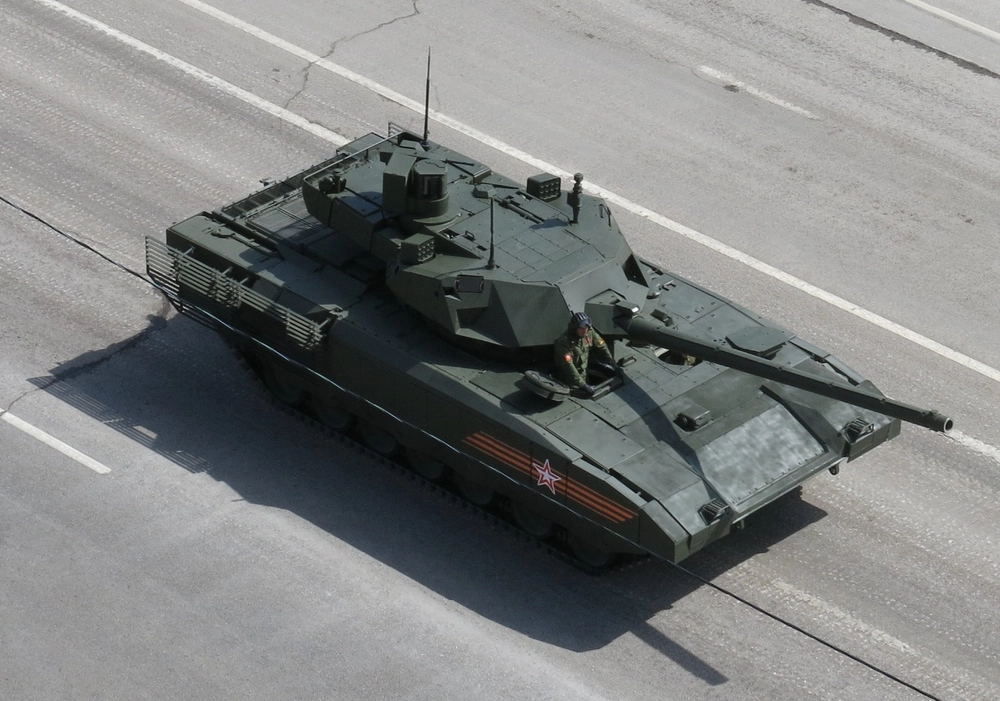Russia has Amazing Tank Ammunition, but Not Many Tanks Can Use It

Sebastien Roblin
T-14 Armata, Europe
Well, this is certainly an unexpected predicament.
Key point: Moscow wants to be able to damage and kill NATO's tanks from a distance. Its new round allows that, but now Russia needs enough T-14s that can actually use them.
The Soviet Union's huge tank fleet was a cornerstone of its power during the Cold War. However, events in the 1991 Gulf War called its superiority into question. On February 26, 1991, a cavalry troop of nine M1 Abrams tanks and twelve Bradley fighting vehicles bumped into an armored brigade of Iraqi T-72 tanks of the elite Tawakalna Republican Guard division. Within twenty-three minutes of frenzied firing, the troop destroyed thirty-seven of the Soviet-designed T-72s without losing a vehicle in return.
(This first appeared earlier in 2019.)
Such outcomes were not solely a result of superior U.S. training. Iraqi tankers did sometimes land multiple hits on M1 tanks, but their shells failed to penetrate the Abram's frontal armor. Not one M1 was destroyed by hostile fire in the war.
Russian tank enthusiasts are quick to point out that the Soviet Union did not export to Iraq it's more advanced 125-millimeter armor-piercing sabot shells, some of which used dense tungsten or depleted-uranium for increased penetrating power. After the USSR's dissolution, Russian engineer continued developing improved ammunition. However, the effective thickness of frontal armor on Western tanks also increased by roughly 50 percent.
Todays, T-72s remain Russia's primary main battle tank, supplemented by turbine-engine T-80s and four hundred more advanced T-90s. All carry variants of the 125-millimeter 2A46 smoothbore cannon, which loads its ammunition using a rotating 'carousel' mechanism instead of human loader. You can see the carousel in operation in this video.
Tanks employ a variety of different ammunition, including fragmenting high-explosive (HE) shells for combatting personnel and light vehicles, and high-explosive-anti-tank (HEAT) shells employing shaped charges that blast a jet of molten metal when they strike their target. Because HEAT shells do operate based on kinetic energy, they do not lose power over distance. Russian tanks can also fire guided missiles through their gun tubes which use use HEAT warheads. Though slower than a shell, missiles are more accurate against very distant targets.
However, modern main battle tanks employ arrays of composite and/or explosive reactive armor, sometimes combined with active protection systems, which are particularly effective at defeating HEAT charges. Thus, the tank-busting munition of choice remains the kinetic-energy Armor-Piercing Find-Discarding Sabot (APFDS).
An APFDS round consists of a dart-like penetrator rod of ultra-dense metal contained within an finned aluminum "sabot," which blossoms away like the petal of a flower upon exiting the gun tube, as you can see in this video. Kinetic penetrators do lose energy over distance, but are very difficult to defeat by means other than bulky armor.
Penetration can be augmented by increasing shell velocity (typically by lengthening the gun barrel), or increasing mass by enlarging shell diameter (difficult, as it considerably increases weight), the length of its penetrating rod, or the density of its metal.
Today, the Abrams, Leopard 2 and Challenger 2 are believed to possess frontal armor roughly equivalent to eight hundred millimeters of Rolled Homogenous Armor. Russia's best armor-piercing shells compatible with the 2A46M gun is the 3BM59 Svinets-1 and 3BM60 Svinets-2, made of tungsten and depleted uranium respectively. These are estimated to penetrate 650 to 750 millimeters of 60-degree sloped armor at a medium combat distance of 2 kilometers (1.24 miles).
This still apparently leaves the Russian shells at a deficit versus Western armor, though not a hopeless one: they could still penetrate at shorter distances, or by striking the universally much weaker side or rear armor of any main battle tank. Purists will maintain the better (or luckier) tank crew can still prevail, but the challenge remains steep for Russian tankers, especially given the superior sights and fire control systems on Western tanks.
Making Sure the Ruby Sabot Fits
The Svinets was declared ready for production around 2002–2005, but evidence of mass production only emerged in 2016, which gives an idea of the arthritic financing of Russian defense programs. One problem was that the Svinets had penetrator rods 740 millimeters long, whereas the autoloaders on T-72s and T-80s could accommodate a maximum ammunition size of 640 millimeters. Thus enlarged 2A46M-5 and M-4 autoloaders had to be installed on upgraded tanks.
Russian engineers meanwhile were developing a huge new 2A83
-Abstract Truncated-
Publisher URL: https://nationalinterest.org/blog/reboot/russia-has-amazing-tank-ammunition-not-many-tanks-can-use-it-192506
DOI: 3163.15116.c228a500-385a-4408-abce-42258de6aeda.1630062843
Keeping up-to-date with research can feel impossible, with papers being published faster than you'll ever be able to read them. That's where Researcher comes in: we're simplifying discovery and making important discussions happen. With over 19,000 sources, including peer-reviewed journals, preprints, blogs, universities, podcasts and Live events across 10 research areas, you'll never miss what's important to you. It's like social media, but better. Oh, and we should mention - it's free.
Researcher displays publicly available abstracts and doesn’t host any full article content. If the content is open access, we will direct clicks from the abstracts to the publisher website and display the PDF copy on our platform. Clicks to view the full text will be directed to the publisher website, where only users with subscriptions or access through their institution are able to view the full article.


